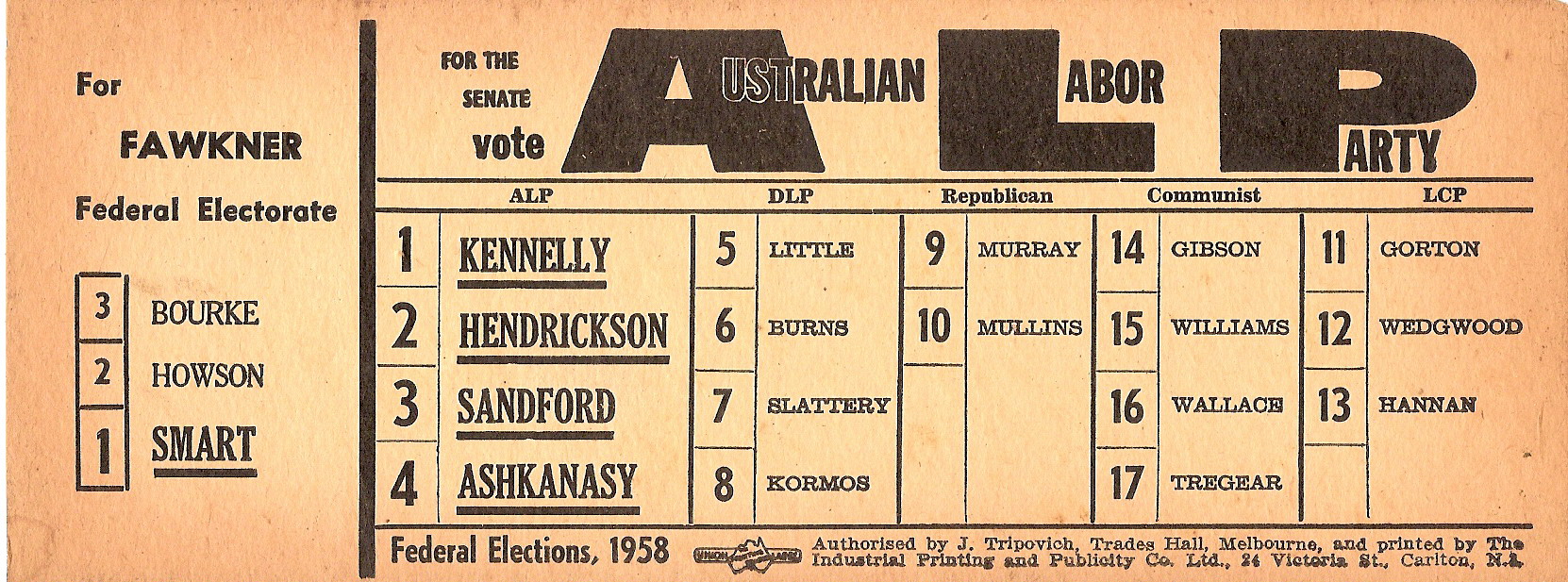After the narrow defeat of Labor at the 1954 Federal elections, Dr. Evatt brought factional issues into the public arena by blaming the disloyalty of Groupers for his defeat. He demanded that the Federal Executive investigate the influence of Groupers in the Victorian Branch. At a Special Federal Conference in Hobart in March 1955, the ALP supported Evatt and recommended that the Industrial Groups should be closed down. By this stage the time for compromise had passed and Groupers walked out of the party, blaming it for giving aid to the Communist cause. Seven Victorian Federal MPs and a Tasmanian Senator formed a separate party, firstly called the ALP Anti-Communist, which in 1957 changed its name to Democratic Labor Party (DLP).
In the Victorian Parliament twelve MPs in the Lower House and six in the Upper House abandoned Labor to join the new party. The DLP attracted support in all the States, but always had its base in Victoria. In Queensland some of the same issues resulted in a separate split in 1957 that brought down the Labor government. Dislodged Premier, Vince Gair, formed the Queensland Labor Party which later joined the DLP. The by-product of that split was the end of Labor administration in that state which had lasted, with only one short break at the beginning of the Depression, from 1915 to 1957. It installed a coalition led by the Country (later National) Party that would keep Labor out of office till 1989, for much of that period led by a determinedly anti-Labor Joh Bjelke-Petersen.
The DLP split in its early years (1954-1958) was a genuine crisis affecting the very survival of the Labor Party in Australia. If there had been a major split in NSW, as there had been in Victoria, the Groupers would probably have completely reshaped the values and institutions of the Labor Party. At that time a Labor government in office in Sydney, led by a Catholic Premier, Joe Cahill, was extremely anxious that the split over Communism and Catholicism should not bring it down. There was no suspicion that the conservative Cahill government was in any way sympathetic to Communism, and, although Catholics were influential in the NSW party, they had never exerted a sectarian influence. The NSW ALP survived by repudiating the Industrial Groups, with the support of Catholics in the party. Despite what is sometimes claimed, there was a split in the NSW ALP at this time: defenders of the Industrial Groups, led by ALP Assistant Secretary Jack Kane, formed a NSW DLP, supported by a section of the trade union movement that had been taken over by the Groupers and would now withhold its funding from the ALP. However, the NSW split was always contained because it had very little electoral support in that state. Direction from the NSW Catholic bishops, especially Sydney's Cardinal Gilroy and Bishop Carroll, convinced most Catholics to retain their Labor identification. A Labor government survived in NSW until 1965, when its defeat owed very little to the DLP factor.
Although it maintained some socially progressive policies on its books, the DLP was always an anti-Labor party. The strategy was to deny office to the ALP until all connections with Communists were cut. In effect this enslaved the party to the interests of the Liberal-Country Party coalition which could always rely upon receiving DLP preferences in elections without giving significant concessions to the DLP in return. The party also had a more permanent impact in that it attracted support very strongly from Catholic voters, especially in Victoria. Most Australian Catholic voters still supported the ALP, but there is a sense in which the DLP helped to separate Labor from an appreciable proportion of Catholic voters, who, when the DLP eventually collapsed, would not return to Labor.
The DLP split, by separating the Groupers from the party, left control in the Federal ALP with the Left. This control over the next two decades came to be personified in FE (Joe) Chamberlain. He had migrated to Western Australia from England as a young man after serving a term as a conscript at the end of the Great War. He found employment in odd jobs and share farming until settling on work on the trams in Perth. He quickly became secretary of that union and a skilled union advocate before the WA Court of Arbitration. He then graduated to WA State Secretary of the ALP in 1949, and remained a member of the Federal Executive for the next 30 years, exercising enormous influence on the party. He was an old-style industrial militant, opposed to 'the enemy within' whether that enemy was Communist, Grouper, or even (in a long Labor industrialist tradition) any politician seeking to ignore party policy. Through the critical years of the split he dominated the Federal Executive as President (1955-61) and Federal Secretary (1961-63). One of his biographers has referred to him as 'showing a resistance to change and an unwillingness to compromise that over the years caused many controversies'. There was never any question about Chamberlain's honesty and integrity, or of his authoritarian disposition.

